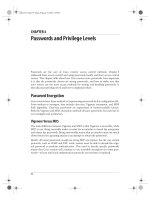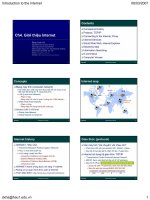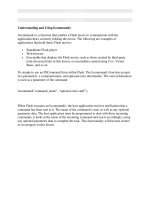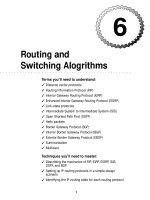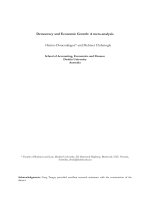Tài liệu Strategy And The Internet pdf
Bạn đang xem bản rút gọn của tài liệu. Xem và tải ngay bản đầy đủ của tài liệu tại đây (430.04 KB, 19 trang )
Strategy and the Internet
by Michael E. Porter
Reprint r0103d
HBR Case Study r0103a
Mommy-Track Backlash
Alden M. Hayashi
First Person r0103b
The Job No CEO Should Delegate
Larry Bossidy
HBR at Large r0103c
The Nut Island Effect:
When Good Teams Go Wrong
Paul F. Levy
Strategy and the Internet r0103d
Michael E. Porter
Building the Emotional Intelligence r0103e
of Groups
Vanessa Urch Druskat and Steven B. Wolff
Not All M&As Are Alike – and That Matters r0103f
Introducing T-Shaped Managers: r0103g
Knowledge Management’s Next Generation
Morten T. Hansen and Bolko von Oetinger
HBR Interview r0103h
Tom Siebel of Siebel Systems:
High Tech the Old-Fashioned Way
Bronwyn Fryer
Best Practice r0103j
Unleash Innovation in Foreign Subsidiaries
Julian Birkinshaw and Neil Hood
Tool Kit r0103k
Making the Most of On-Line Recruiting
Peter Cappelli
Books in Review r0103l
Playing Around with Brainstorming
Michael Schrage
March 2001
Joseph L. Bower
62
Copyright © 2001 by Harvard Business School Publishing Corporation. All rights reserved.
Many have argued that the Internet renders strategy obsolete.
In reality, the opposite is true. Because the Internet tends to weaken
industry profitability without providing proprietary operational
advantages, it is more important than ever for companies to
distinguish themselves through strategy. The winners will be those
that view the Internet as a complement to, not a cannibal of,
traditional ways of competing.
Strategy
Internet
by Michael E. Porter
he Internet is an extremely important new
technology, and it is no surprise that it has
received so much attention from entrepreneurs,
executives, investors, and business observers.
Caught up in the general fervor, many have as-
sumed that the Internet changes everything, ren-
dering all the old rules about companies and com-
petition obsolete. That may be a natural reaction,
but it is a dangerous one. It has led many compa-
nies, dot-coms and incumbents alike, to make bad
decisions –decisions that have eroded the attrac-
tiveness of their industries and undermined their
own competitive advantages. Some companies, for
example, have used Internet technology to shift
the basis of competition away from quality, fea-
tures, and service and toward price, making it
harder for anyone in their industries to turn a
profit. Others have forfeited important proprietary
advantages by rushing into misguided partnerships
march 2001
63
and
the
T
ILLUSTRATION BY MICHAEL GIBBS
64
harvard business review
Strategy and the Internet
and outsourcing relationships. Until recently, the negative
effects of these actions have been obscured by distorted
signals from the marketplace. Now, however, the conse-
quences are becoming evident.
The time has come to take a clearer view of the Inter-
net. We need to move away from the rhetoric about
“Internet industries,” “e-business strategies,” and a “new
economy”and see the Internet for what it is: an enabling
technology –a powerful set of tools that can be used,
wisely or unwisely, in almost any industry and as part of
almost any strategy. We need to ask fundamental ques-
tions: Who will capture the economic benefits that the
Internet creates? Will all the value end up going to cus-
tomers, or will companies be able to reap a share of it?
What will be the Internet’s impact on industry structure?
Will it expand or shrink the pool of profits? And what will
be its impact on strategy? Will the Internet bolster or
erode the ability of companies to gain sustainable advan-
tages over their competitors?
In addressing these questions, much of what we find is
unsettling. I believe that the experiences companies have
had with the Internet thus far must be largely discounted
and that many of the lessons learned must be forgotten.
When seen with fresh eyes, it becomes clear that the In-
ternet is not necessarily a blessing. It tends to alter indus-
try structures in ways that dampen overall profitability,
and it has a leveling effect on business practices, reducing
the ability of any company to establish an operational
advantage that can be sustained.
The key question is not whether to deploy Internet
technology –companies have no choice if they want to
stay competitive–but how to deploy it. Here, there is rea-
son for optimism. Internet technology provides better op-
portunities for companies to establish distinctive strategic
positionings than did previous generations of informa-
tion technology. Gaining such a competitive advantage
does not require a radically new approach to business. It
requires building on the proven principles of effective
strategy. The Internet per se will rarely be a competitive
advantage. Many of the companies that succeed will be
ones that use the Internet as a complement to traditional
ways of competing, not those that set their Internet ini-
tiatives apart from their established operations. That is
particularly good news for established companies, which
are often in the best position to meld Internet and tradi-
tional approaches in ways that buttress existing advan-
tages. But dot-coms can also be winners –if they under-
stand the trade-offs between Internet and traditional
approaches and can fashion truly distinctive strategies.
Far from making strategy less important, as some have
argued, the Internet actually makes strategy more essen-
tial than ever.
Distorted Market Signals
Companies that have deployed Internet technology have
been confused by distorted market signals, often of their
own creation. It is understandable, when confronted with
a new business phenomenon, to look to marketplace out-
comes for guidance. But in the early stages of the rollout
of any important new technology, market signals can be
unreliable. New technologies trigger rampant experi-
mentation, by both companies and customers, and the
experimentation is often economically unsustainable. As
a result, market behavior is distorted and must be inter-
preted with caution.
That is certainly the case with the Internet. Consider
the revenue side of the profit equation in industries in
which Internet technology is widely used. Sales figures
have been unreliable for three reasons. First, many com-
panies have subsidized the purchase of their products and
services in hopes of staking out a position on the Internet
and attracting a base of customers. (Governments have
also subsidized on-line shopping by exempting it from
sales taxes.) Buyers have been able to purchase goods at
heavy discounts, or even obtain them for free, rather than
pay prices that reflect true costs. When prices are artifi-
cially low, unit demand becomes artificially high. Second,
many buyers have been drawn to the Internet out of
curiosity; they have been willing to conduct transactions
on-line even when the benefits have been uncertain or
limited. If Amazon.com offers an equal or lower price
than a conventional bookstore and free or subsidized
shipping, why not try it as an experiment? Sooner or later,
though, some customers can be expected to return to
more traditional modes of commerce, especially if sub-
sidies end, making any assessment of customer loyalty
based on conditions so far suspect. Finally, some “rev-
enues” from on-line commerce have been received in the
form of stock rather than cash. Much of the estimated
$450 million in revenues that Amazon has recognized
from its corporate partners, for example, has come as
stock. The sustainability of such revenue is questionable,
and its true value hinges on fluctuations in stock prices.
If revenue is an elusive concept on the Internet, cost is
equally fuzzy. Many companies doing business on-line
have enjoyed subsidized inputs. Their suppliers, eager to
affiliate themselves with and learn from dot-com leaders,
have provided products, services, and content at heavily
discounted prices. Many content providers, for example,
Michael E. Porter is the Bishop William Lawrence Univer-
sity Professor at Harvard University; he is based at Har-
vard Business School in Boston. He has written many arti-
cles for HBR; the most recent,“Philanthropy’s New Agenda:
Creating Value,” coauthored by Mark R. Kramer, appeared
in the November–December 1999 issue. His book Can Japan
Compete?, coauthored by Hirotaka Takeuchi and Mariko
Sakakibara, was recently published in the United States by
Perseus/Basic Books.
march 2001
65
Strategy and the Internet
rushed to provide their information to Yahoo! for next to
nothing in hopes of establishing a beachhead on one of
the Internet’s most visited sites. Some providers have even
paid popular portals to distribute their content. Further
masking true costs, many suppliers –not to mention em-
ployees –have agreed to accept equity, warrants, or stock
options from Internet-related companies and ventures in
payment for their services or products. Payment in equity
does not appear on the income statement, but it is a real
cost to shareholders. Such supplier practices have artifi-
cially depressed the costs of doing business on the Inter-
net, making it appear more attractive than it really is.
Finally, costs have been distorted by the systematic un-
derstatement of the need for capital. Company after com-
pany touted the low asset intensity of doing business on-
line, only to find that inventory, warehouses, and other
investments were necessary to provide value to customers.
Signals from the stock market have been even more
unreliable. Responding to investor enthusiasm over the
Internet’s explosive growth, stock valuations became
decoupled from business fundamentals. They no longer
provided an accurate guide as to whether real economic
value was being created. Any company that has made
competitive decisions based on influencing near-term
share price or responding to investor sentiments has put
itself at risk.
Distorted revenues, costs, and share prices have been
matched by the unreliability of the financial metrics that
companies have adopted. The executives of companies
conducting business over the Internet have, conveniently,
downplayed traditional measures of profitability and eco-
nomic value. Instead, they have emphasized expansive
definitions of revenue, numbers
of customers, or, even more
suspect, measures that might
someday correlate with reve-
nue, such as numbers of unique
users (“reach”), numbers of site
visitors, or click-through rates.
Creative accounting approaches
have also multiplied. Indeed, the Internet has given rise to
an array of new performance metrics that have only a
loose relationship to economic value, such as pro forma
measures of income that remove “nonrecurring”costs like
acquisitions. The dubious connection between reported
metrics and actual profitability has served only to amplify
the confusing signals about what has been working in the
marketplace. The fact that those metrics have been taken
seriously by the stock market has muddied the waters
even further. For all these reasons, the true financial per-
formance of many Internet-related businesses is even
worse than has been stated.
One might argue that the simple proliferation of dot-
coms is a sign of the economic value of the Internet. Such
a conclusion is premature at best. Dot-coms multiplied
so rapidly for one major reason: they were able to raise
capital without having to demonstrate viability. Rather
than signaling a healthy business environment, the sheer
number of dot-coms in many industries often revealed
nothing more than the existence of low barriers to entry,
always a danger sign.
A Return to Fundamentals
It is hard to come to any firm understanding of the impact
of the Internet on business by looking at the results to
date. But two broad conclusions can be drawn. First, many
businesses active on the Internet are artificial businesses
competing by artificial means and propped up by capital
that until recently had been readily available. Second, in
periods of transition such as the one we have been going
through, it often appears as if there are new rules of com-
petition. But as market forces play out, as they are now,
the old rules regain their currency. The creation of true
economic value once again becomes the final arbiter of
business success.
Economic value for a company is nothing more than
the gap between price and cost, and it is reliably mea-
sured only by sustained profitability. To generate rev-
enues, reduce expenses, or simply do something useful by
deploying Internet technology is not sufficient evidence
that value has been created. Nor is a company’s current
stock price necessarily an indicator of economic value.
Shareholder value is a reliable measure of economic
value only over the long run.
In thinking about economic value, it is useful to draw
a distinction between the uses of the Internet (such as
operating digital marketplaces, selling toys, or trading
securities) and Internet technologies (such as site-cus-
tomization tools or real-time communications services),
which can be deployed across many uses. Many have
pointed to the success of technology providers as evi-
dence of the Internet’s economic value. But this thinking
is faulty. It is the uses of the Internet that ultimately
create economic value. Technology providers can prosper
for a time irrespective of whether the uses of the Internet
are profitable. In periods of heavy experimentation, even
sellers of flawed technologies can thrive. But unless the
uses generate sustainable revenues or savings in excess of
their cost of deployment, the opportunity for technology
providers will shrivel as companies realize that further
investment is economically unsound.
Internet technology provides better opportunities for
companies to establish distinctive strategic positionings
than did previous generations of information technology.
66
harvard business review
Strategy and the Internet
So how can the Internet be used to create economic
value? To find the answer, we need to look beyond the im-
mediate market signals to the two fundamental factors
that determine profitability:
• industry structure, which determines the profitability of
the average competitor; and
• sustainable competitive advantage, which allows a com-
pany to outperform the average competitor.
These two underlying drivers of profitability are uni-
versal; they transcend any technology or type of business.
At the same time, they vary widely by industry and com-
pany. The broad, supra-industry classifications so common
in Internet parlance, such as business-to-consumer (or
“B2C”) and business-to-business (or “B2B”) prove mean-
ingless with respect to profitability. Potential profitability
can be understood only by looking at individual indus-
tries and individual companies.
The Internet and Industry Structure
The Internet has created some new industries, such as
on-line auctions and digital marketplaces. However, its
greatest impact has been to enable the reconfiguration
of existing industries that had been constrained by high
costs for communicating, gathering information, or ac-
complishing transactions. Distance learning, for example,
has existed for decades, with about one million students
enrolling in correspondence courses every year. The In-
ternet has the potential to greatly expand distance learn-
ing, but it did not create the industry. Similarly, the Inter-
net provides an efficient means to order products, but
catalog retailers with toll-free numbers and automated
fulfillment centers have been around for decades. The In-
ternet only changes the front end of the process.
Whether an industry is new or old, its structural attrac-
tiveness is determined by five underlying forces of com-
petition: the intensity of rivalry among existing competi-
tors, the barriers to entry for new competitors, the threat
of substitute products or services, the bargaining power of
suppliers, and the bargaining power of buyers. In combi-
nation, these forces determine how the economic value
created by any product, service, technology, or way of
competing is divided between, on the one hand, compa-
nies in an industry and, on the other, customers, suppliers,
distributors, substitutes, and potential new entrants. Al-
though some have argued that today’s rapid pace of tech-
nological change makes industry analysis less valuable,
the opposite is true. Analyzing the forces illuminates an
industry’s fundamental attractiveness, exposes the under-
lying drivers of average industry profitability, and provides
insight into how profitability will evolve in the future. The
five competitive forces still determine profitability even if
suppliers, channels, substitutes, or competitors change.
Because the strength of each of the five forces varies
considerably from industry to industry, it would be a
mistake to draw general conclusions about the impact
of the Internet on long-term industry profitability; each
industry is affected in different ways. Nevertheless, an
examination of a wide range of industries in which the
Internet is playing a role reveals some clear trends, as
summarized in the exhibit “How the Internet Influences
Industry Structure.” Some of the trends are positive. For
example, the Internet tends to dampen the bargaining
power of channels by providing companies with new,
more direct avenues to customers. The Internet can also
boost an industry’s efficiency in various ways, expanding
the overall size of the market by improving its position
relative to traditional substitutes.
But most of the trends are negative. Internet technol-
ogy provides buyers with easier access to information
about products and suppliers, thus bolstering buyer bar-
gaining power. The Internet mitigates the need for such
things as an established sales force or access to existing
channels, reducing barriers to entry. By enabling new
approaches to meeting needs and performing functions,
it creates new substitutes. Because it is an open system,
companies have more difficulty maintaining proprietary
offerings, thus intensifying the rivalry among competi-
tors. The use of the Internet also tends to expand the
geographic market, bringing many more companies into
competition with one another. And Internet technologies
tend to reduce variable costs and tilt cost structures to-
ward fixed cost, creating significantly greater pressure for
companies to engage in destructive price competition.
While deploying the Internet can expand the market,
then, doing so often comes at the expense of average prof-
itability. The great paradox of the Internet is that its very
benefits –making information widely available; reducing
the difficulty of purchasing, marketing, and distribution;
allowing buyers and sellers to find and transact business
with one another more easily–also make it more difficult
for companies to capture those benefits as profits.
We can see this dynamic at work in automobile retail-
ing. The Internet allows customers to gather extensive
information about products easily, from detailed speci-
fications and repair records to wholesale prices for new
cars and average values for used cars. Customers can also
choose among many more options from which to buy, not
just local dealers but also various types of Internet refer-
ral networks (such as Autoweb and AutoVantage) and on-
line direct dealers (such as Autobytel.com, AutoNation,
and CarsDirect.com). Because the Internet reduces the
importance of location, at least for the initial sale, it
widens the geographic market from local to regional or
national. Virtually every dealer or dealer group becomes
a potential competitor in the market. It is more difficult,
moreover, for on-line dealers to differentiate themselves,
as they lack potential points of distinction such as show-
rooms, personal selling, and service departments. With
more competitors selling largely undifferentiated prod-
